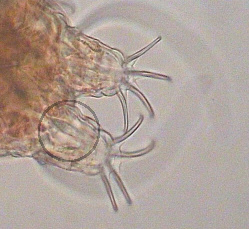We will have a short look at water bear anatomy in this
issue.
Of course, one might wonder how much anatomy in fact will be necessary
for a microscope amateur: it is possibly to enjoy microscopic life without any
knowledge in anatomy, same as it is possible to enjoy a talk with a friend
without being so much interested in the bone structure of this person.
And you will agree that only very brute people would cut their dog into pieces
just in order to have a look into its interior anatomic details.
So we will try to restrict our studies to those details in anatomy which can be
studied at the living water bear without doing any harm to it.
So, what do you perceive in the photography below? |
![[Title fragment 1.1]](t1_1.gif)
![[Title fragment 1.2]](t1_2e.gif)
![[Title fragment 1.3]](t1_3e.gif)
![[Title fragment 3.1]](t3_1.gif)
![[Title fragment 3.2]](t3_2.gif)
![[Title fragment 3.3]](t3_3e.gif)
![[Title fragment 1.1]](t1_1.gif)
![[Title fragment 1.2]](t1_2e.gif)
![[Title fragment 1.3]](t1_3e.gif)
![[Title fragment 3.1]](t3_1.gif)
![[Title fragment 3.2]](t3_2.gif)
![[Title fragment 3.3]](t3_3e.gif)
![[Echiniscus legs]](./mai2001/m_klaue2.jpg)
![[Echiniscus legs]](./mai2001/m_klaue3.jpg)
